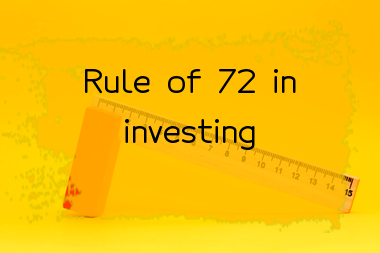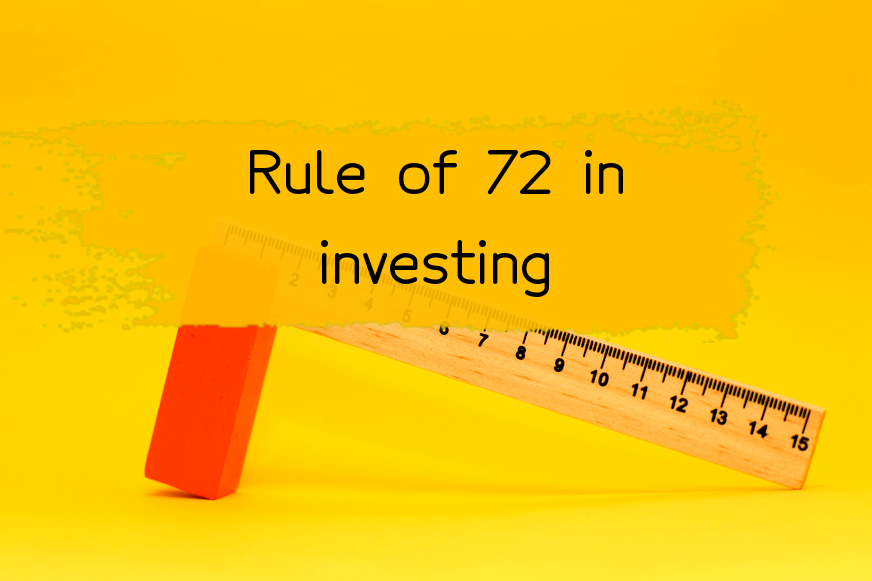The Rule of 72 is a simple mathematical formula used to estimate the number of years it would take to double an investment based on the annual rate of return. To use the Rule of 72, divide 72 by the annual rate of return as a percentage. The result is the approximate number of years it would take for the investment to double in value.
For example, if an investment has an annual return of 8%, using the Rule of 72, we can calculate that it would take approximately 9 years for the investment to double in value (72/8=9).
The Rule of 72 is a useful tool for investors to quickly estimate the potential growth of their investments over time. However, it is important to note that the rule does not account for fluctuations in the market or other factors that could impact investment returns.
What' the Rule of 72 in Finance?
The rule of 72 is a simple mathematical formula used in finance to determine how long an investment will take to double in value. It goes as follows: divide 72 by the annual rate of return (or interest rate) on the investment to get the approximate number of years it will take for the investment to double in value. For example, if an investment has an annual rate of return of 8%, it will take about 9 years (72 divided by 8) for the investment to double in value. The rule of 72 can be used for both simple and compound interest investments.
Formula for the Rule of 72
The Rule of 72 is a simple mathematical formula that is used to estimate the amount of time it takes for an investment to double given a fixed annual rate of interest. The formula for the Rule of 72 is:
Number of years to double = 72 / Annual rate of return
For example, if you have an investment with an annual rate of return of 6%, it will take approximately 12 years for your investment to double in value based on the Rule of 72. (72 / 6 = 12). This formula is an approximation and assumes a constant rate of return, but it can provide an easy way to estimate the time it will take to double your investment.
Uses of the Rule of 72 in Investing
The Rule of 72 is a quick and easy way to estimate how long it will take for an investment to double in value, or how quickly inflation will erode the value of your money. Here are some specific uses of the Rule of 72 in investing:
- 1Understanding the power of compound interest: The Rule of 72 can help you see how quickly your investments can grow over time through the magic of compound interest. For example, if you invest $10,000 at an annual rate of return of 8%, your money will double to $20,000 in approximately 9 years (72/8=9). If you leave that money invested for another 9 years, it will double again to $40,000.
- 2Comparing investment options: The Rule of 72 can help you quickly compare the potential returns of different investment options. For example, if you have the choice between two investments, one that offers a 6% annual return and one that offers an 8% annual return, you can use the Rule of 72 to estimate that the 6% investment will double in about 12 years (72/6=12) while the 8% investment will double in about 9 years (72/8=9).
- 3Understanding the impact of fees and expenses: The Rule of 72 can help you see how fees and expenses can eat into your investment returns over time. For example, if you pay an annual fee of 1% on your investments, your money will take approximately 72 years to double (72/1=72), significantly longer than if you had invested in a low-cost index fund with fees of 0.05%.
- 4Estimating the effects of inflation: The Rule of 72 can also be used to estimate how quickly inflation will erode the value of your money. If you expect annual inflation of 3%, your money will lose half its purchasing power in approximately 24 years (72/3=24), meaning that $1 today will be worth only around 50 cents in 24 years. This can help you plan for retirement and understand the importance of investing for long-term growth.
Limitations of the Rule of 72
The rule of 72 is a simple tool used to approximate the number of years it takes for an investment to double in value. However, there are several limitations to this rule:
- 1The rule of 72 assumes a fixed rate of return, which may not be the case in reality. Investments can experience significant fluctuations in returns, making it difficult to accurately predict when they will double in value.
- 2The rule of 72 only works for calculating the time it takes for an investment to double in value. It cannot be used to calculate the exact value of an investment at a specific point in time or to determine the optimal investment strategy.
- 3The rule of 72 does not take into account inflation, which can significantly impact the purchasing power of an investment over time.
- 4The rule of 72 assumes that the investment is compounded annually, which may not be the case with all investments. Interest may be compounded monthly or quarterly, which can affect the time it takes for an investment to double in value.
- 5The rule of 72 does not factor in taxes or fees, which can reduce the overall return on an investment. Therefore, the actual time it takes for an investment to double in value may be longer than predicted by the rule of 72.
- 6The rule of 72 cannot predict a potential loss in investment, which is a significant risk of investing. It is important to note that investing involves risk, and there is no guarantee that an investment will double in value or even generate positive returns.
Variations on the Rule of 72
The Rule of 72 is a simple mathematical formula that estimates the number of years it will take for an investment to double in value, based on the interest rate or growth rate. However, there are variations to this rule that can provide more accurate estimates or apply to different scenarios:
- 1. Rule of 70: This is a slight variation of the Rule of 72, which assumes that an investment will take 70/interest rate years to double in value, rather than 72. The Rule of 70 is more accurate for growth rates that are not evenly divisible by 72.
- 2. Rule of 18: This is a modified version of the Rule of 72, which can be used to estimate the time it takes for an investment to quadruple in value. Instead of dividing 72 by the annual growth rate, you divide 18 by the annual growth rate to get the number of years it will take for the investment to quadruple.
- 3. Rule of 114: This rule estimates how long it takes for an investment to increase in value by ten times. The Rule of 114 calculates the number of years it takes to do that by dividing 114 by the annual growth rate.
- 4. Rule of 144: This rule estimates how long it takes for an investment to increase in value by 100 times. The Rule of 144 calculates the number of years it takes to do that by dividing 144 by the annual growth rate.
- 5. Reverse Rule of 72: This rule estimates the interest rate that an investment must earn to double in value in a specified period. To calculate the interest rate, divide 72 by the number of years it will take for the investment to double.
Just one more thing: if you liked the article, please like us on social media and share this article with friends.



